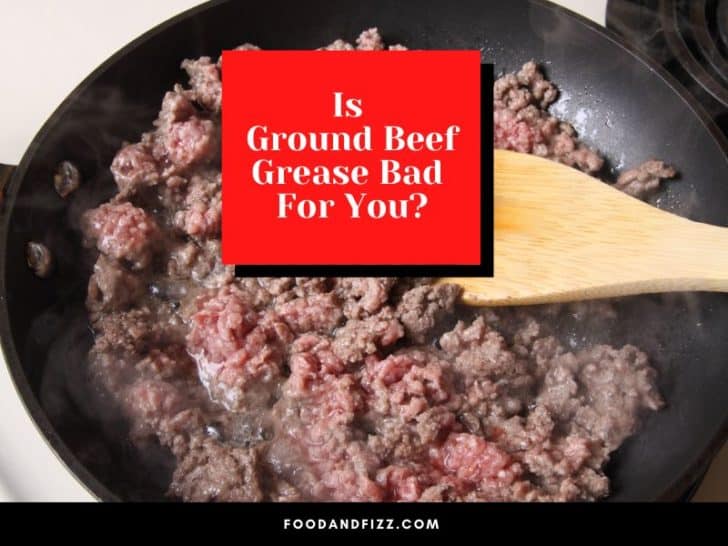Ground beef is a popular ingredient in many dishes, from hamburgers to spaghetti Bolognese. But there is a lot of disagreement about whether or not eating the grease that is made when ground beef is cooked is bad for you. In this article, we will explore whether ground beef grease is bad for you.
That oily leftover grease glistening in the pan after cooking burgers or tacos is tempting. It adds such rich, beefy flavor to food. But with all that saturated fat and cholesterol, is ground beef grease actually unhealthy? Or is it an OK cooking fat in moderation? I’ll break down the health effects to help you decide.
When ground beef cooks, the fat melts out into the pan, leaving behind a slick layer of grease The more fat in the beef, the more grease rendered An 80/20 blend can yield nearly 50% saturated fat drippings.
This animal fat does contain some vitamins from the meat But grease itself is basically pure calories and fat, with no carbs, protein, or anything else. The concern is its high saturated fat content
Is All That Saturated Fat Bad?
Here’s where opinions differ on beef tallow. Saturated fats raise “bad” LDL cholesterol levels. And diets high in sat fat are tied to heart disease. But some experts argue beef grease may not be that awful.
Potential benefits of using ground beef grease include:
-
Provides fatty acids needed to produce hormones
-
Helps absorb fat-soluble vitamins A, D, E, K
-
Adds super savory umami flavor to dishes
-
May support feeling full by slowing digestion
So in moderation, beef tallow offers some upside. But going overboard does pose risks, especially if you already have high cholesterol or heart health issues.
Health Dangers of Too Much Grease
Despite the potential benefits, large amounts of ground beef grease can negatively impact health:
-
Heart disease – Saturated fats raise “bad” LDL cholesterol levels in the blood. This can lead to plaque buildup in arteries over time.
-
Weight gain – With 120 calories per tablespoon, grease packs a big caloric punch that promotes excess weight.
-
Diabetes – Diets high in saturated fat are linked to insulin resistance and type 2 diabetes.
-
Inflammation – Grease may trigger systemic inflammation and oxidative stress.
-
Cancer – Some research connects high saturated fat intake with certain cancers, but more studies are needed.
How Much Can You Safely Consume?
Given the upsides and downsides, how much ground beef grease is OK? Here are some tips on moderate, healthy intake:
-
Limit to about 1-2 tablespoons daily
-
Less than 10% of total calories from saturated fat
-
Balance with unsaturated fats like olive oil
-
Minimize for heart disease, diabetes, obesity
-
Choose leaner beef cuts to reduce grease
The key is using just enough for flavor without going overboard. Watch out for hidden sources in burgers, tacos, chili, etc. too.
Healthy Substitutions for Grease
To limit beef tallow for health reasons, what are some good alternatives? Try these more heart-healthy oils:
-
Olive oil – High in monounsaturated fats, mix into patties
-
Avocado oil – Mild flavor with monounsaturated fats, saute veggies
-
Walnut oil – Provides omega-3s and a nutty aroma, great on Brussels sprouts
-
Vegetable broth – Use as the base for braising instead of grease
-
Saute mushrooms before browning beef to cut down on drippings
You can reduce grease without losing the yummy flavors. Get creative blending small amounts of beef tallow with these plant-based fats and liquids when cooking.
Proper Disposal of Leftover Grease
Once you’re done cooking, avoid pouring grease down drains. It can clog pipes! Let it cool then transfer into a container with a tight lid. Here are some safe grease disposal options:
-
Throw sealed jar in the trash
-
Compost if you have an industrial composter
-
Donate used grease for recycling into biofuels
-
Store and reuse for the next time you cook
Disposing of grease properly keeps plumbing running smoothly and avoids water pollution. Just a few easy steps help handle beef tallow the right way after cooking.
The Bottom Line on Ground Beef Grease
To sum up, beef tallow does contain high levels of saturated fat that may negatively impact heart health. But in moderation, it can be incorporated as part of an overall balanced diet.
Be mindful of portion sizes when cooking with grease, opt for leaner beef, balance with vegetable oils, and properly dispose of leftovers after cooking. With a little care taken, you can still enjoy the rich, beefy flavors of ground beef drippings as part of healthy home cooking.

Is Ground Beef Grease Bad for You?
Consuming large amounts of ground beef grease can be harmful to your health. A lot of saturated fat is in the grease. This can make you more likely to get heart disease, high blood pressure, and other health problems. Additionally, consuming too much saturated fat can raise your cholesterol levels and contribute to weight gain.
But eating small amounts of ground beef grease once in a while probably won’t have a big effect on your health. Some people think that ground beef grease can make food taste better and add moisture, so they use it in small amounts to make their food taste better.
What is Ground Beef Grease?
The liquid fat that is made when you cook ground beef is called ground beef grease. It is also called beef fat or tallow. Most people throw it away or drain it off while the food is cooking, but some people choose to keep it and eat it.
Keep the fat do not drain it carnivore diet
FAQ
Should I remove grease from ground beef?
Is it bad to eat the fat from ground beef?
Is it bad to eat meat grease?
Is grease from grass fed beef healthy?
